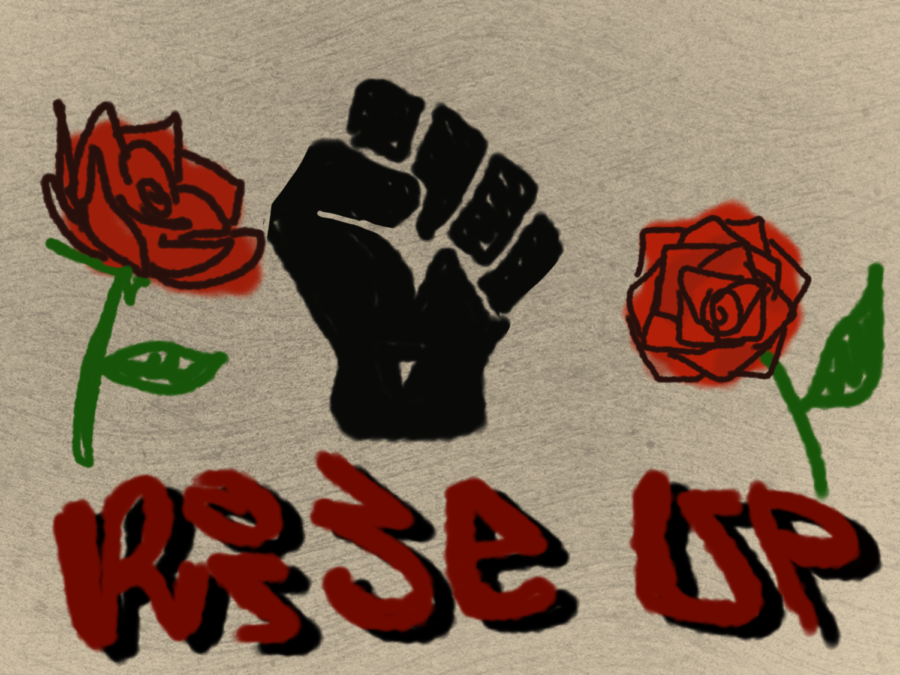How artists have utilized their mediums for activism
A common art piece throughout the Black Lives Matter Movement has been the symbol of a raised fist.
March 2, 2023
Many mediums of art have been used to protest causes. Whether it be dance, music, literature, film or visual arts, it has been used time and time again. Activism through art is important because it is a long-standing approach for many to communicate what they feel.
In 1998, Portugal’s vote towards abortion rights failed. In response, Paula Rego, a Portuguese artist, created a 10 piece series to highlight the psychological pain and dangers that come with outlawing abortions. She centered her work around how restricting abortions only leads to an increase in unsafe abortions, rather than eliminating them. (National Art Galleries) “Making abortions legal is forcing women to the backstreet solution,” she said in a 2019 interview with The Guardian.
In 2007, Portugal had another vote towards legalizing abortion and it passed. Many believe that Rego contributed to this massive achievement.
Yilmaz Güney, a Kurdish filmmaker from Turkey, started his journey of protest in 1961 by writing a “communist” novel that detailed some of the injustices facing the Kurds, a predominantly Muslim ethnic minority. This landed him in jail for 18 months. Güney eventually broke away from Turkey and its film industry and started producing his own films that highlighted the true feelings of Kurdish people.
He released three films, “Hope,” “Agit,” and “Umutsuzlar,” meaning “they are desperate,” from 1970 to 1972. After that, however, he spent a total of 12 years in jail and continued to write his scripts behind bars. Güney’s works caused so much commotion within Turkey that the government began to outlaw his movies and would burn copies when they found them. Güney’s works helped spread the feelings and circumstances of the Kurdish people further than ever hoped for.
Activism does not just have to be something tangible such as art or film. It is something a person experiences and witnesses. The goal of activism is to leave a mark and alter someone’s brain chemistry. Activism through dance had a major increase in popularity during the 1900s.
Martha Graham, a recipient of the National Medal of Arts, voiced her beliefs through dance. Her influence developed due to her focus on inner emotions. She aimed to hit different topics and introduce their emotional impact to the world, such as the Great Depression, the Spanish Civil War, and injustices in America and fascism. She choreographed “Chronicle” in response to fascism in Europe. She refused to participate in the 1936 Olympics in Germany due to many of the artists who she respected being persecuted and deprived of the right to work due to being Jewish.
She choreographed “Deep Song” and “Immediate Tragedy” in response to the Spanish Civil War, and “American Document” to highlight American history, injustices, and democracy. It looked into the hardships that faced America, including discrimination against Native Americans and slavery. Graham soon realized that this piece could also be used to protest fascism due to its focus on rights and freedom.
Pearl Primus, born in Trinidad, was an American dancer, choreographer and anthropologist. Her family immigrated to America when she was two years old. In 1948, she received a Rosenwald Foundation Scholarship, which allowed her to travel to Africa. She documented the way of life of the people living there and their dance. She also studied the diaspora of African American dance, visiting the Caribbean to gather research as well. Once back in the US, she created countless choreographies about her learnings. They communicate the hardships of racial oppression and discrimination. Her first work, “African Ceremonial,” came out in 1944. Since then, she has gone on to produce many more.
One of her more famous choreographies, “Strange Fruit,” took on a very different approach towards protesting racial discrimination. Primus danced to express the emotions of a white woman who had just witnessed a lynching. She emphasized the disgust and sadness coming from the bystander. For her works she received many awards, including the National Medal of Arts and the Distinguished Service Award.
Activism through art is important, as it allows us as humans to reach deep into our spiritual and emotional realm and share part of our mind with the rest of the world. In his book, “Humanity,” Chinese artist and activist Ai Weiwei said, “If anything, art is… about morals, about our belief in humanity. Without that, there simply is no art.”



